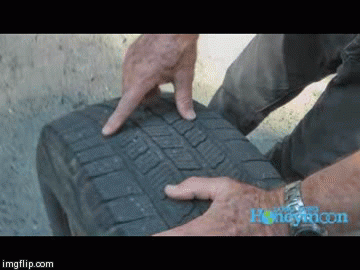Recently we bought two new Michelin tires (http://goo.gl/GKwaEg) for our tow vehicle, a Ford F250 truck we call SEEMORE. We bought them via the Internet at a significant savings over what we could find locally.
TWO INSTEAD OF FOUR
First of all, why did we buy two new tires instead of four? Quite simply, because we only needed two new tires. Our front tires were balder than Telly Savalas (does anyone else remember Telly Savalas?). But our back tires had some tread remaining, so we just bought two tires to mount on the front of the vehicle. We’ll replace the other two when they are ready.

When tread is worn down to the “wear bars,” SEEMORE gets a new pair of shoes. (Click the pic to browse tires for your own tow vehicle.)
Towing a travel trailer or other RV creates disproportionate front-and-back tire wear. The weight of the RV puts a lot of stress on the tow vehicle’s rear tires, so they wear out more quickly. We rotate the tires (swapping front and back, and side to side) to reduce the disproportionate effect of the wear.
In our case, although we rotated the tires frequently, we had two tires displaying much more wear than the others. I believe this is because those two unlucky tires served as our rear tires last year when we drove to Alaska and back. The Alaska Highway is a beautiful road, but it’s not easy on tires.

If your tires remind you of Telly Savalas, it’s time for fresh rubber. (Click the pic to go tire browsing.)
THE TRUTH ABOUT TIRE WARRANTIES
Our truck tire of choice is the Michelin LTX M/S 2 (http://goo.gl/GKwaEg). These tires are supposedly warrantied for 70,000 miles of wear. Did we get 70,000 miles on the two worn out tires? No! We got about 50,000 miles.
Since we fell 20,000 miles short of expectations, the worn out tires were covered under warranty, right? Yes and (mostly) no. The so called tire mileage warranty is only valid if you rotate the tires every 7500 miles, there is no “sign of unusual wear” that could be attributed to an alignment issue, and the original seller is in a generous mood.
Even if the warranty applies, it only contributes a small prorated amount (say, $50 or $100) towards the purchase of new tires.
In other words, don’t get too caught up in manufacturer warranty claims. If and when you make a claim, the seller will look for reasons to deny it.
(I could launch into a detailed behind-the-scenes expose of our experience here, and completely rip our original tire seller; wouldn’t that be fun? Suffice to say that I no longer really trust tire warranties. They are sales tools.)
So this time around, we shopped for tires based on up front out-of-pocket price. Overall I was happy with the ride and performance of the Michelins, even though they suffered some excess wear on our trip to Alaska. We got about the same longevity from the Michelins as the Continentals that originally came with SEEMORE. Actually, the Michelins did a little better than the Contis since we only had to change two after 50,000 miles.
BUYING TIRES ON THE INTERNET
The best price I found on our preferred model was – unsurprisingly – on Amazon via the Long Long Honeymoon Supply Store. The Amazon tire & wheel store works great – just enter your vehicle make and model, and you get all sorts of tire choices.

This is the tire we chose for SEEMORE, our F250. CLICK THE PIC to browse tires for your own vehicle.
So we ordered two tires from Amazon (free shipping, no tax) and had them mounted & balanced by a local independent shop for $25 a tire. Going this route saved us about $50 per tire over the prices we were being quoted locally. So we saved $100 total on these two tires, and will save another $100 on the next set of two we purchase. Hey, $200 is $200.
Note that when buying tires on the Internet, you need to make absolutely certain you are buying the correct tires. It’s more than size that matters – the load index rating is crucial too.
For example, Michelin sells the same tire in the same size with different load index ratings. Installing the incorrect load index for your truck is a bad idea – don’t do it. In our case, this meant we needed a tire with a load index of 123R to properly match our vehicle. If we had bought the same model tire with a load index of 114T, it would have been too weak for our big ‘ol truck. We would have experienced more sidewall flex, increased wear, and possibly unsafe performance.
Our new tires were shipped to us via UPS. Since we were traveling in our Airstream, we took delivery at the local UPS customer service center.
CONCLUSION
If you want to save some money on a new set of tires, buying on the Internet is a good way to go. We ended up with the exact tires we wanted at the lowest price.
The most important lessons?
First, be absolutely certain that you are ordering the correct tire size and load index rating.
Second, research local installers to get price quotes for mounting and balancing the tires. You might also check whether they offer any kind of long term rotation benefit.
